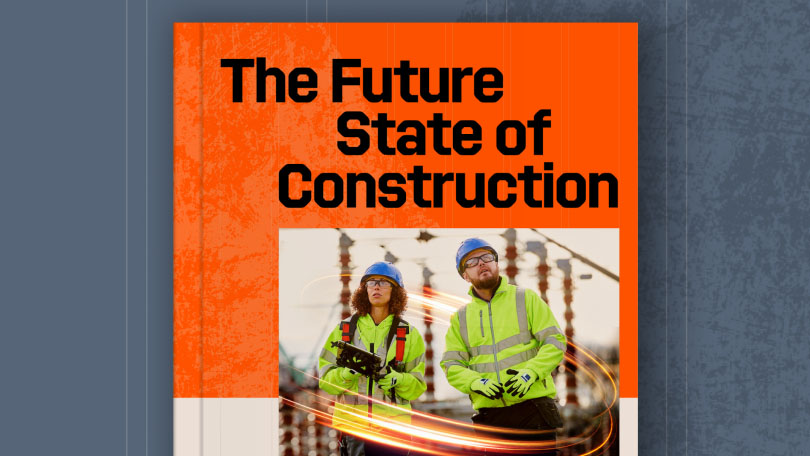— 7 min read
Preventing Construction Disputes with Smart Contract Management

Last Updated Aug 28, 2025

Adarsh George
Adarsh George is a seasoned contracts and commercial manager with over a decade of experience delivering complex, multi-disciplinary projects valued at over £2.3 billion. He specialises in cost-efficient contract strategies, NEC/FIDIC frameworks, and proactive risk management—playing a key role in driving SGN’s transition to hydrogen-ready networks and the UK’s broader Net Zero goals. Adarsh blends an engineering foundation with commercial and legal acumen, having successfully led contract negotiations, defended high-value claims, and improved project spend efficiency across real estate and utilities sectors. Outside of work, he draws creative inspiration from his practice in ceramics - bringing the same patience and structure to both wheel-thrown pottery and construction delivery

Zoe Mullan
27 articles
Zoe Mullan is an experienced content writer and editor with a background in marketing and communications in the e-learning sector. Zoe holds an MA in English Literature and History from the University of Glasgow and a PGDip in Journalism from the University of Strathclyde and lives in Northern Ireland.
Last Updated Aug 28, 2025

Table of contents
A Strategic Framework for Modern Construction
Humans have always built megastructures with pride. From the Pyramids of Giza to Dubai's Burj Khalifa and Saudi Arabia's NEOM, there will always be "the next big project." However, as construction projects grow larger and more complex, they create greater potential for claims, delays, and disputes.
While modern technology – from AI-driven analytics to predictive modelling – transforms how we deliver construction, it isn't a silver bullet. The foundational safeguard against chaos in these high-stakes environments isn't just digital – it's contractual governance.
Why Construction Projects Face Inevitable Disputes
The construction industry operates in perpetual controlled chaos. Fluctuating material prices, unforeseen site conditions, and shifting project scopes create an environment where Murphy's Law prevails: "anything that can go wrong will go wrong." Consequently, seasoned contract managers recognise these uncertainties as red flags for potential disputes.
The smartest strategy for dispute resolution is avoiding disputes altogether. This requires identifying potential causes and understanding what drives major disputes across the industry. The root causes consistently fall into four primary categories:
Delays that disrupt project timelines
Cost overruns that exceed budgets
Quality deficiencies that fail to meet specifications
Payment conflicts that strain cash flow
Each category represents not just commercial risk, but relationship breakdown between parties who should work towards shared objectives.
Real-World Challenges: The Infrastructure Replacement Paradox
In my current role managing the replacement of iron gas mains with new zero-carbon gas-ready pipes towards the UK’s net zero vision, dispute challenges are magnified by the inherent uncertainty of infrastructure replacement projects. The challenge lies in what I call the “excavation paradox” – we genuinely don’t know what we’ll encounter when digging trenches or modifying existing infrastructure. This fundamental uncertainty changes how we must approach contract management, requiring frameworks that embrace adaptability while maintaining commercial discipline.

Adarsh George
Choosing the Right Contract Framework
From FIDIC to NEC: A Philosophical Shift
The shift from managing Fédération Internationale des Ingénieurs-Conseils (FIDIC) construction contracts to adopting the New Engineering Contract (NEC) isn't just procedural – it's philosophical. Whilst FIDIC contracts are comprehensive, they often create adversarial frameworks where parties protect their own interests.
In contrast, the NEC's collaborative approach fundamentally reframes relationship dynamics. Its core clause requires parties to act "in a spirit of mutual trust and co-operation." This isn't just contractual language – it's a behavioural mandate that transforms project dynamics.
Geographic adoption patterns reveal market preferences: NEC dominates in the United Kingdom, New Zealand, and Hong Kong, reflecting markets that embrace collaborative construction delivery. Meanwhile, FIDIC's continued prevalence in the Middle East and Asia demonstrates how traditional procurement approaches influence dispute frequencies.
The NEC Advantage in Practice
With the NEC, it’s not us versus them – it’s us together versus project uncertainties, or the defect, or the risks. It’s getting past that blame game and working together towards a solution for mutual benefit.

Adarsh George
The NEC encourages transparency and proactive issue management. For instance, its requirement for early warning notices compels contractors and project managers to surface risks before they escalate into major problems.
The Four Pillars of Dispute Prevention
No contract eliminates disputes without a disciplined approach. Therefore, follow this simple guiding principle: clarity before commitment.
Define Scope and Boundaries Precisely
Every successful project begins with a crystal-clear scope definition. Vague specifications and ambiguous deliverables breed disputes. The scope document – or activity schedule in NEC terminology – becomes the project's DNA, defining not just what teams will build, but how they'll measure success.
Allocate and Mitigate Risks Clearly
Clear risk allocation prevents the blame game that characterises failed projects. Each party must understand not just their responsibilities, but also their exposure and mitigation strategies. This transparency eliminates confusion when problems arise.
Establish Timeline Certainty and Milestone Definition
Programme clarity extends beyond critical path analysis. It requires a shared understanding of dependencies, resource requirements, and milestone achievement criteria. Teams need definitive schedules that everyone can follow and measure against.
Structure Payment Mechanisms and Commercial Frameworks
Financial clarity prevents cash flow disputes and ensures project viability for all parties. Clear payment terms, milestone triggers, and commercial arrangements eliminate ambiguity that leads to conflict.
Documentation: The First Line of Defence
Misunderstandings about scope, timelines, deliverables, or payment terms can escalate into formal disputes. Therefore, maintaining a clear paper trail that supports every project detail and decision becomes crucial for preventing disputes.
Keeping this document trail stored in a common data environment (CDE) or construction management platform helps keep everybody aligned. However, the transformation from physical filing systems to cloud-based platforms and specialised construction management systems has fundamentally changed how we maintain project records.
The Digital Documentation Revolution
When I started my career in construction, change requests were printed, signed, and filed manually. Today, platforms like SharePoint, DocuSign and CDEs have revolutionised how we manage data and workflows.

Adarsh George
Technology alone doesn't solve the documentation challenge – it simply provides better tools for systematic record-keeping. More importantly, organisations should establish documentation protocols that capture decisions in real-time, not retrospectively.
Warning sign: When teams start scrambling for information – requesting copies of drawings, instructions, or correspondence they should already have – this often indicates brewing disputes.
Changing Mindsets to Prevent Disputes
While NEC contracts help the shift to clarity and collaboration, changing mindsets requires additional work. Companies must approach projects as teams, not disconnected groups of people. Since people easily develop working habits, organisations need to bring them along on the journey towards new thinking and technology.
Management consultant Peter Drucker observed, "Culture eats strategy for breakfast." In construction, this means that even the best contracts and procedures fail without cultural buy-in from all project participants.
Building a Collaborative Culture
Successful contract compliance transformation requires comprehensive education across all organisational levels:
- Site-Level Training: Ensure operatives understand how their daily decisions impact contractual obligations and dispute risk.
- Management Development: Equip project managers with conflict resolution skills and early intervention techniques that prevent escalation.
- Commercial Awareness: Build understanding of how contractual mechanisms translate into business outcomes for sustainable success.
External training providers with hands-on NEC experience can accelerate this cultural transformation. However, real change happens through consistent reinforcement of collaborative behaviours throughout the project lifecycle.
Lock the Scope Early
The scope of work document – or activity schedule, as the NEC defines it – ranks as perhaps the most important document for preventing disputes. Contract specialists spend the most time with this document during contract formalisation because it defines what must be completed, to what standard, and within what timeframes.
The document breaks down activities and assigns responsibilities, which proves key to creating clear contracts.
The scope of work drives any form of contract. I can use different contract types, but if my scope is not well defined, this leaves room for all kinds of disputes.

Adarsh George
Since unclear scope causes most claims, construction teams need to lock scope as early as possible. This means both parties must agree on scope and capture a final version that becomes the master scope document.
Digital version control becomes important here to prevent teams from accidentally working from previous scope iterations. Once teams lock the scope, any changes require formal variation orders.
Spot Potential Disputes Before They Escalate
Pro Tip
Experienced contract managers develop an intuitive sense for when projects head towards conflict. Teams start asking for all correspondence relating to certain issues or requesting hard copies of digital communications when they're usually building legal files.
A good indicator that a dispute will likely occur is when teams start scrambling for information such as drawings or instructions. This signals they're trying to prepare documentation for legal teams.

Adarsh George
At this point, direct communication can often prevent escalation. Early intervention requires courage and diplomatic skill – addressing uncomfortable issues before they become entrenched. Sometimes, simple conversations resolve what might otherwise lead to expensive legal battles.
Building Dispute-Free Projects
Dispute prevention isn't just about eliminating conflict – it's about channelling inevitable disagreements into productive problem-solving. The NEC's collaborative framework, combined with rigorous scope management, proactive documentation, and cultural transformation, creates a foundation for industry-wide improvement.
The most successful projects I've managed were those where dispute prevention became everyone's responsibility, not just the contract manager's burden. When site operatives understand how their decisions impact contractual compliance, when project managers prioritise relationship maintenance, and when senior management reinforces collaborative behaviours, disputes become rare exceptions rather than expected outcomes.

Adarsh George
By implementing these strategies systematically, construction teams can transform potential conflicts into collaborative solutions that strengthen projects and relationships for long-term success.
Written by

Adarsh George
Adarsh George is a seasoned contracts and commercial manager with over a decade of experience delivering complex, multi-disciplinary projects valued at over £2.3 billion. He specialises in cost-efficient contract strategies, NEC/FIDIC frameworks, and proactive risk management—playing a key role in driving SGN’s transition to hydrogen-ready networks and the UK’s broader Net Zero goals. Adarsh blends an engineering foundation with commercial and legal acumen, having successfully led contract negotiations, defended high-value claims, and improved project spend efficiency across real estate and utilities sectors. Outside of work, he draws creative inspiration from his practice in ceramics - bringing the same patience and structure to both wheel-thrown pottery and construction delivery
View profileReviewed by

Zoe Mullan
27 articles
Zoe Mullan is an experienced content writer and editor with a background in marketing and communications in the e-learning sector. Zoe holds an MA in English Literature and History from the University of Glasgow and a PGDip in Journalism from the University of Strathclyde and lives in Northern Ireland.
View profileExplore more helpful resources

Construction Management Contracts: A Complete UK Guide
Managing construction contracts can lead to an extensive physical paper trail. Sharing contracts, getting signatures and managing timelines is difficult when teams and clients are scattered across job sites and...

Key Differences Between Contractors & Subcontractors
In UK commercial construction, main (or principal) contractors engage directly with project owners to deliver complete construction programmes, while subcontractors perform specific scopes of work under the main contractor’s management....

The Role of RFPs in UK Construction Projects
Requests for Proposals (RFPs) are a core document for construction procurement in the United Kingdom. Effective RFPs align expectations, establish clear evaluation criteria, and create accountability between clients and contractors....

Financial Management in Construction Projects
Effective financial management can make or break construction projects. Teams that master budgeting, cash flow and cost control are better positioned to deliver projects on time, within budget and with...
